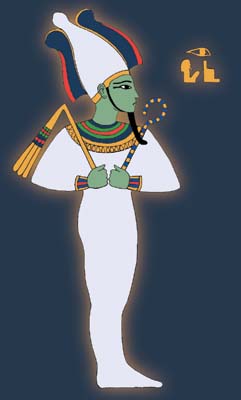Haker Feast of Osiris
Hab Haker

Probably one of the most sacred cities of ancient Egypt was Abydos, or Abju in the Egyptian language. In the beginnings of their recorded history it was a burial ground for kings; starting about the 5th Dynasty it became the center of worship for Osiris, "Lord of Abju, Foremost of the Westerners [the blessed dead]". His major annual festival was the Haker Feast. While there is some scholarly debate on the particulars of this important religious festival, what we do know today comes largely from the memorial monuments of officials who went on pilgrimage to Abydos as envoys of the ruling pharaoh.
The Haker Feast took place during the latter part of Ka-Hor-Ka ("Khoiakh" in Greek), which was the fourth month of Akhet (flood season). On our calendar, it would be late October to early November. While it does bear some resemblance to our modern Halloween in that it commemorates the death and burial of Osiris--and, by extension, departed loved ones--it differs in that the Haker Feast is a planting festival rather than a harvest festival. By mid-October, the Nile floodwaters would have subsided and planting could begin. (In Egypt's desert climate, the winter months are cooler but still quite warm compared to more temperate regions!) Burying seeds in the ground became a metaphor for burial of the dead, and families would make clay figures of Osiris and push seeds into them to sprout, symbolizing resurrection.
A major element of Egyptian festivals was the god- or gods' procession through their home town. The Haker Feast included two such processions; the first featured Wepwawet, a wolf or jackal deity similar to Anubis. His name meaning "Opener of the Way", Wepwawet was represented by a priest in a jackal mask. In local Abydos tradition, Wepwawet was son of Osiris and as part of the Haker Feast he "defended his father" in mock battle with the enemies of Osiris. "The way" thus opened, Osiris could then proceed.
Osiris' oracle statue would then be led out from the temple, along a route through the cemetary of Abydos. Scores of stelae (tablets) and votive statues have been found along this route, where ancient Egyptians hoped to participate spiritually in Osiris' celebration. Part of the procession also included the "god's boat-journey" in a portable ceremonial boat, called the Neshmet barque. Priests carried it to a shrine called Poqer in the desert outside Abydos; here Osiris was ceremonially 'reburied', that is, enshrined in his 'tomb' for a night of vigil. While priests performed secret rites during the vigil, the Wepwawet priest conducted a mock trial of Set, murderer of Osiris. The passion play ended with the mock slaughter of Osiris' enemies.
It's quite possible that celebrants at the Haker Feast stayed up all night to observe Osiris' vigil, although the rites at Poqer were conducted by only the higher echelons of priests. We do know from some records that Osiris was "transfigured" and given the "crown of justification"; perhaps a variant of the funeral rites were re-enacted on the oracle statue. The next day, Osiris made a triumphant return through the city on his Neshmet barque, back to the main temple of Abydos.
Egyptians hoped to participate in the Haker Feast, either by a pilgrimage during their lifetimes or by leaving votive memorials along the parade route, because Osiris' symbolic defeat of death meant the promise of resurrection for the common person as well. Offerings made to Osiris were placed afterwards in the chapels of Abydos' cemetary, and scores of inscriptions from noblemen express the wish that they could share in his bounty of offerings. When 19th-Dynasty pharaoh Seti I had another temple built in Abydos, his famous Kings List was actually part of an elaborate offering inscription dedicated to all the kings who had come before. Unfortunately, because Tutankhamun's name had been usurped from monuments shortly after his death, his name was left out of the Abydos Kings List. Famous as he is today, though, their attempts to exclude Tutankhamun from Osiris' blessings were ultimately for naught.
References:
Collier, Mark, and Manley, Bill. How to Read Egyptian Hieroglyphs: A Step-By-Step Guide to Teach Yourself. Berkeley: University of California Press, 1998.
Watterson, Barbara. The Gods of Ancient Egypt. Bicester, England: Facts on File Publications, 1984.
Back to Temple Main Page